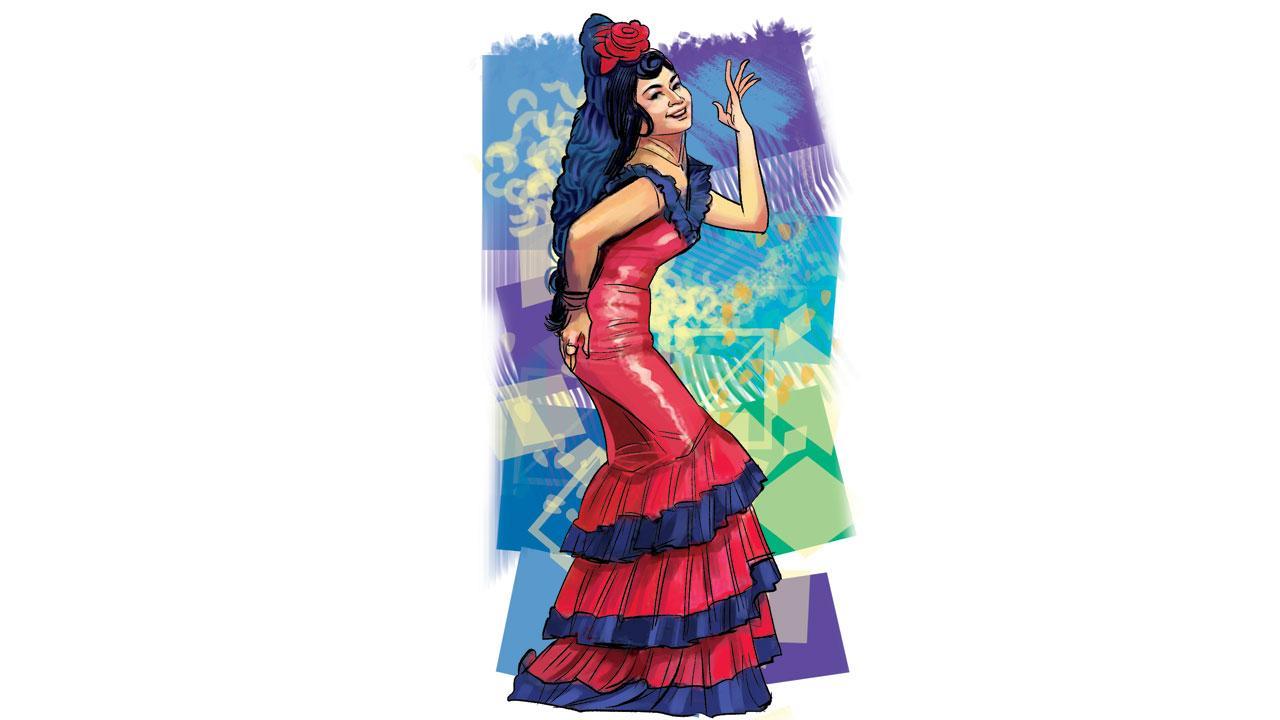Usha Iyer’s book is a fantastic and meticulous analysis of dancing women in Hindi cinema from 1930-1990s, and also including Tamil and Bengali cinema

Illustration/Uday Mohite
![]() I’ve always been fascinated by dance. Any dance, including Bollywood. I’ve even taken classes in the lavani dance from Gururaj Korgaonkarji. It’s a traditional Maharashtrian folk dance, heavy duty or halka-sa erotic, depending on how you interpret it. I have been obsessed with Apsara aali, the lavani from Ravi Jadhav’s Natarang, and Sanjay Leela Bhansali’s extraordinary Mohe rang do laal from Bajirao Mastani. How even in a Hindi masala mainstream film, he shows incredible political daring, celebrating a historical, Hindu-Muslim romance in a time of right wing ascendancy, and combining multiple classical elements—Hindustani classical music, classical dance (kathak), ragamalika paintings and the tribute to Mughal-e-Azam. So it was with utter delight that I swooped on Usha Iyer’s book Dancing Women: Choreographing Corporeal Histories of Hindi Cinema (Oxford University Press, Rs 1,550 paperback).
I’ve always been fascinated by dance. Any dance, including Bollywood. I’ve even taken classes in the lavani dance from Gururaj Korgaonkarji. It’s a traditional Maharashtrian folk dance, heavy duty or halka-sa erotic, depending on how you interpret it. I have been obsessed with Apsara aali, the lavani from Ravi Jadhav’s Natarang, and Sanjay Leela Bhansali’s extraordinary Mohe rang do laal from Bajirao Mastani. How even in a Hindi masala mainstream film, he shows incredible political daring, celebrating a historical, Hindu-Muslim romance in a time of right wing ascendancy, and combining multiple classical elements—Hindustani classical music, classical dance (kathak), ragamalika paintings and the tribute to Mughal-e-Azam. So it was with utter delight that I swooped on Usha Iyer’s book Dancing Women: Choreographing Corporeal Histories of Hindi Cinema (Oxford University Press, Rs 1,550 paperback).
ADVERTISEMENT
Usha Iyer’s book is a fantastic and meticulous analysis of dancing women in Hindi cinema from 1930-1990s, and also including Tamil and Bengali cinema. She studies these dancing women through the lenses of choreography, feminism, female desire, agency, labour (all the people involved in ‘song picturisation’, including choreographer, stand-ins, music composers, lyricists, singers, musicians, background dancers), history, caste, religion, colonialism, sexuality, the dancer’s status vis-à-vis the heroine and hero, their mobility (dancing-wise and status-wise) and more. Despite its academic instincts—it bristles with “choreographing architectures of public intimacy” and “a movement-based taxonomy of song-and-dance sequences,” the knowledge and passion that it passes on to us is incomparable. Iyer quotes from interviews with many dancers and choreographers, including Waheeda Rehman, Vyjayanthimala, Madhuri Dixit and Saroj Khan. There’s even a password-protected website to accompany the book, with short clips of many of the dance numbers it discusses. Iyer, a PhD from the University of Pittsburgh, is Assistant Professor of Film and Media Studies in the Department of Art and Art History at Stanford University, US.
Also read: It's KGF chapter 3 before Salaar 2 for director Prashant Neel
Take the dance face-off Muqabla humse na karo (Don’t compete with me), with Vyjayanthimala, Helen and Shammi Kapoor from Prince (Lekh Tandon, 1969). The set-up, with Vyjayanthimala’s Indian Bharatanatynam-inspired dance and Helen’s Western “loose-limbed insouciance”, rather than one of competition, shows us “their delight in each other’s performance, and by sharing performance space and time equally between the heroine, vamp and hero”. She discusses how dance allowed dancers like Vyjayanthimala (‘Tamil Hindu’) and Waheeda Rehman (‘Tamil Muslim’) upward mobility to become star actresses. Star dancers had agency over films they danced in; the hero was relatively less important. And the rich irony, as they became star actresses and had fewer dances, their roles became more domesticated to the hero. There’s Helen’s advice: “Every girl should flirt with the man who’s handling the camera, and not with the hero, producer or the director. If she makes the photographer feel wanted, he’ll make her look gorgeous, giving her an edge over the leading lady.” See “Piya tu ab toh aaja” with Helen’s explosive cabaret chewing the scenery, with the morally upright Asha Parekh sitting like a terrified rabbit, as Helen and the cinematographer swoop, slide and slither over every possible surface. She discusses multiple influences on dancing women, including devdasis, Muslim baijis, Anna Pavlova, Azurie, the Indo-German dancer and Madame Simkie; how Madhuri Dixit and Saroj Khan—two women—collaborated in all those salacious dances (Ek do teen, choli ke peeche kya hai? ‘What is behind the blouse?’), how “Hindu dances” devalued “Muslim dances” especially in the nationalist and Independence era. How Hindi cinema’s “Hinduised reform agenda” usually tries to domesticate the bad, dancing girl into a good, non-dancing wife (Sadhna, Devdas, Guide, Teesri Kasam, etc), Iyer observes. But in Teesri Kasam, when Raj Kapoor proposes marriage to Waheeda Rehman’s dancing girl, she has a devastating line about the uselessness of marriage: “Kahin aisa na ho, ki Hiradevi ko koi chahne wala na ho, aur Hirabai ko koi dekhne wala na ho (What if there is no one to love Hira Devi [the wife] and no one to look at Hira Bai [the stage actress]. Three full-on sitis to that!
Meenakshi Shedde is India and South Asia Delegate to the Berlin International Film Festival, National Award-winning critic, curator to festivals worldwide and journalist.
Reach her at meenakshi.shedde@mid-day.com
 Subscribe today by clicking the link and stay updated with the latest news!" Click here!
Subscribe today by clicking the link and stay updated with the latest news!" Click here!







